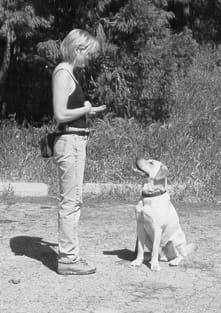Well over a decade ago, I enrolled my Terrier mix, Josie, in an obedience class with Judie Howard at Arydith Obedience School in Moraga, California, and was startled on the first day of class to discover that Judie advocated using food in training.
At that time, conventional wisdom frowned heavily on the use of food for training purposes; Judie was one of the first nationally acclaimed competition trainers to admit – no, to boast of – using food in her training programs. Of course, it took no time at all for me to thoroughly convert to using this powerful training tool, because of both its tremendous success rate and its ability to engage a dog’s attention and enthusiasm.
In order to accommodate the baggies-full of hot dog ‘pennies’ that we learned to spit from our mouths to our dogs’, one of Judie’s assistants designed and created denim bait bags that clipped onto your belt, laid flat against your hip, and snapped closed. We wore the bags as a badge of honor, knowing that they identified us as one of Judie’s students.
As the popularity of using treats and bait bags grew, however, so did the debate over whether or not bait bags were a good dog-training tool. The arguments in favor of baits bags are mostly obvious. They offer a handy, easily accessible place to carry your dog’s favorite snacks. They protect your clothes from being permeated with hot dog slime and essence of freeze-dried liver. String cheese does not melt as quickly in a bait bag as when it’s held tightly against your body heat in snug blue jean pockets. And finally, the commercially produced bags, made of high-quality nylon in a variety of rich colors, endow the wearer with a certain panache: “Here,” the bags seem to say, “is a serious dog training enthusiast.”
The arguments against bait bags are not so obvious. The most compelling is that the presence of a bait bag is like a flashing neon sign – an obvious cue to your dog that it’s training time and treats are handy. Use a bait bag consistently, and you risk creating a dog who works great when the bait bag is on your hip, but tends to find other activities more rewarding when the neon sign isn’t flashing. In addition, dogs who haven’t yet learned their good manners lessons may try to help themselves to the treats in the bag – and sometimes succeed. Finally, unless the clip that fixes the bag to your side attaches securely to your waist, the bag can fall off and provide your dog with an unexpected (and unearned) jackpot!
Baited breath
I stand firmly in the middle of the bait bag debate. I shop for lots of lightweight, loose-fitting jackets with large pockets so I can stash my bags of treats comfortably on my person without turning on the neon sign. Of course, my dogs know that I have treats in my pockets, but I always have treats in my pockets, so the presence of treats is not the cue that training is happening. Paradoxically, because I always have treats in my pockets, training and treat rewards can (and do) happen anytime, without warning.
On the other hand, there are times during Tennessee’s hot and humid summers that wearing a jacket of any weight is out of the question, and my pants, while a comfortable fit, are not loose enough to accommodate bulging bags of dog yummies in the pockets. On those days I will stuff a few dry cookies in my pockets, but for serious training sessions and to teach classes, I put my bait bag to use. I have one of the early commercially-produced bait bags, and it suffers from the loose-clip syndrome; a bump of my arm or a dog’s head, and it falls to the floor. I was delighted when Whole Dog Journal decided to review bait bags, giving me the opportunity to test several and pick the best to replace my antiquated one.
We evaluated five bags from three different companies. All were well constructed, with good quality materials. Each has different features, however, and your choice for Best Bait Bag will depend on your personal needs and preferences. Some of the differences include closure style (drawstring, Velcro, or hinged); material; size; attachment hardware, lining, color selection, and cost. So take the time to determine what features are important to you, and then go train and cut bait!
Our findings
We have several reasons to justify our selection of Legacy’s Quick Draw Training Pouch as our top pick in bait bags. It’s large enough to hold a good supply of treats. It is well constructed, and has a nice nylon inner lining that can be wiped clean easily. We like the attached belt – no way will this bait bag fall off. We do wish the belt were made of a slightly softer nylon.
But our absolute favorite feature is matched by none of the other bags: the metal French hinge sewn into the mouth of the bag to keep it open or snap it closed at a single touch. Since we usually hold a clicker, a leash, or both in one hand when training, we like a bait bag that can easily be accessed, opened, and closed with just one hand. The French hinge – the same kind used on many change purses – made this bag the easiest to open and close with just one hand. The maker recommends that the user keeps the hinge well-lubricated with an occasional touch of Vaseline.
The bag itself is made af a high quality washable nylon, and the inside is easily wiped clean with a damp sponge.
The Quick Draw Training Pouch does cost a few dollars more than the other bags, but we think it’s worth it!
The Pro LineTracking/Training Bag is for anyone who is very serious about training. Its big advantage is its size. With two good-sized pouches and one humongous one, all with Velcro closures, there is plenty of room for you to carry treats, toys, a leash, your cell phone, a sandwich, and maybe more! This is a great advantage for people whose dogs grow bored of the same treat or toy; you can carry enough different reward items with you to keep any dog interested and engaged, even on a long walk.
We liked it so much we wanted to give it a 4 PAWS rating, except for one fairly glaring flaw – at its smallest adjustment, the waist belt is still way too big for many people – 44 inches at the smallest adjustment. That’s good news for bigger people, but not thinner ones. We’re not accomplished tailors by any stretch, but we like this product well enough that we will get out needle and thread and shorten the belt so we can use it.
Again, for us training fanatics the three pouches on one belt offer a tremendous variety of rewarding opportunities. But if you’re not into hauling lots of training gear around with you, you will probably find this get-up too bulky for your taste.
The large, center pouch is 11 by 8 inches, and the two side pouches are 7 by 6 ½ inches. They close with Velcro, which is not quite as easy to open one-handed as the hinged pouch of the product described above, but easier than the drawstring models described below. None of the pouches are lined, making them more difficult to clean.
Pro Line, maker of the product described above, does make a single-pouch bait bag, the Pro Line Training Bait Bag. It comes with a sturdy plastic clip or a nylon belt.
We liked a lot of things about this bag – its size (7″ x 6½”); the Velcro closure; the plastic D-ring for attaching keys, a tab leash, or your choice of small items. We also liked its two mesh pockets – a small one on the side for (empty) poop bags or a clicker, and a larger one on the front, also with a Velcro closure, for a toy, ball, clicker, and/or other small accessories. If you choose the clip-on model, be careful when you plunge your hand into the bag for a treat; with the clip positioned in the center of the wide bag, it’s easy to make it unclip when rooting in the corners for the last treats. We like the model with the attached belt better, although this belt (like the one on Pro Line?s Tracking/Training Bag) is too big for many people, even at its smallest adjustment.
A more adjustable belt and a lined pouch might have boosted this bait bag into earning our 4 paws rating.
The most beautifully made bait bags we found are manufactured and sold by Doggone Good, a San Jose, California-based company that also makes one of our favorite soft-sided crates. Doggone Good was one of the original producers of commercial bait bags, and they still offer an attractive, high quality product.
Both the Doggone Good ProTrainer Bait Bag and Doggone Good Clicker Bait Bag come with two attachments – a clip and a snap. We love the way you can use one, the other, or both for total security. The bag also features a plastic D-ring for attaching accessories. The nylon lining is another nice feature, making it easy to wipe the inside clean after use.
The smaller size of this bag will appeal to some, although we found ourselves refilling it more often than we’d like. Also, we found the drawstring closure the least convenient of the various styles we tried, requiring two hands to open and close.
Anyone who has used a clicker knows how annoying it is when you forget where you stashed it. Doggone Good’s Clicker Bait Bag solves the problem with a handy pocket for your clicker on the front of the bag. Not losing clickers will reimburse the $1 extra purchase price.
-by Pat Miller







Clicker Bait Bag solves the problem with a handy pocket and is very useful and comfortable while training of the dog its easy to carry and beat bag for training
Where can you purchase the Legacy’s Quick Draw Training Pouch? I cannot find it online anywhere. Thanks